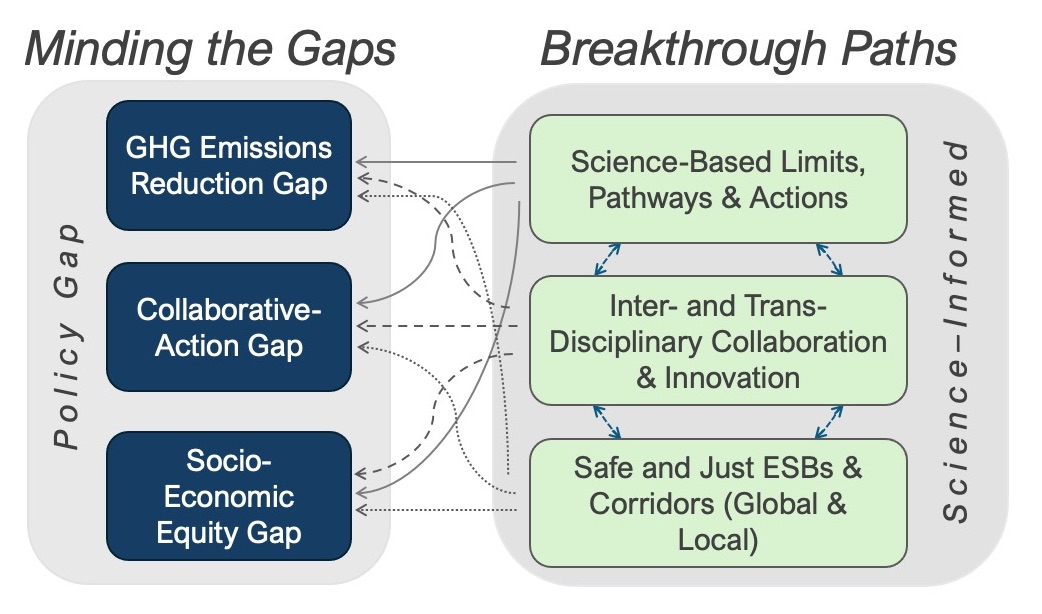
www.buildingsandcities.org/insights/commentaries/researchers-climate-policy-gaps.html
Net-Zero Requires Improved Collaboration between Researchers and Policymakers

Message to COP29: more effective collaboration is essential
The GHG emissions reduction efforts of governments, industries and societies continue to fall short of what is needed. Responsible researchers recognise the critical role of the built environment to meet this challenge and the consequences of climate change. We need to partner with those at the forefront of decision making affecting the building, construction and real estate sector. Interdisciplinary research and transdisciplinary innovation are needed more than ever to support the decision making and practical action of every stakeholder in the sector, especially those shaping the policy landscape.
Matti Kuittinen (Aalto University), Thomas Lützkendorf (Karlsruhe Institute of Technology) and Greg Foliente (University of Melbourne) call for the recognition of this responsibility, and enhanced collaboration between researchers and policymakers. This is an invitation for other scientists to join them in this commitment and offer of support by signing up to this Public Statement.
Minding the gaps

Global warming threatens the stability of the Earth system and, thus, the future of our society. In UNEP's explainer of the global climate emergency (UNEP 2022), it notes that the world is not tracking well to meet the primary aim of the 2015 COP21 Paris Agreement, which is to keep "the increase in the global average temperature to well below 2°C above pre-industrial levels" and pursue efforts "to limit the temperature increase to 1.5°C above pre-industrial levels". Although individual countries declared their Nationally Determined Contribution (NDCs) via legally binding carbon reduction pledges, they have not been meeting their pledges. Thus, the GHG emissions reduction gap is growing, and the time needed to achieve the target is narrowing.
The global average temperature in 2023 was 1.2 °C above the pre-industrial period (National Centres for Environmental Information 2023). Vulnerable communities and people groups have been, and are being, disproportionately impacted by climate related extreme events. Meanwhile, economies that historically and currently contribute the most to GHG emissions have not taken a proportionate emissions reduction target. In other words, there is a massive socio-economic equity gap.
At COP26 Glasgow, in addition to updated NDC pledges, the Breakthrough Agenda was launched to help the world close the widely recognised "collaboration gap" in key sectors and accelerate international action on climate change to meet the Paris Agreement's global decarbonisation objective (Breakthrough Agenda 2021). Since then, an internationally-recognised, annual, COP-centred, collaborative process - backed by 59 countries - has focused on seven key sectors: power, road transport, steel, hydrogen, agriculture, buildings, and cement and concrete, covering over 60% of global emissions.
The Earth Commission has recently quantified the practical challenge that all sectors and actors need to aim for to keep the planet within a safe and just space based on Earth system boundaries (ESBs) (Gupta et al. 2024). This space or corridor is one in which pathways of future human development are both safe and just over time. In overcoming the key gaps to secure this space for humanity, their core nature, interdependencies and scope should be understood and addressed in the context of a jurisdiction or a country's policy landscape (left side of Figure 1). The important role of science and the research community in breaking through these critical gaps is discussed herein.
Minding the built environment
The built environment is an important focus of action because the sector (including the related upstream and downstream processes) accounts for around 40% of energy and process related GHG emissions. However, the use of construction products is growing faster than the global population (OECD 2019), leading to the increased GHG emissions (Zhong et al. 2021). Similarly, operational emissions from energy use are rising by about 1% annually (IEA, IRENA & UN Climate Change High-Level Champions 2023). The embodied emissions of construction products and processes are increasing in both absolute and relative terms for individual buildings (Röck et al. 2020). The opportunities for operational emissions reduction of the building stock are significant, but the retrofit required to reduce the overall carbon footprint needs consideration of financial and carbon payback periods (Seo et al. 2018) as well as organisational and social implications.
Three of the seven key sectors in the Breakthrough Agenda - namely, buildings, steel, and cement and concrete - are core to the built environment and two (power and road transport) are closely related. The Buildings Breakthrough report was the first follow-up report that set out the sector's priority agenda and actions (IEA et al. 2023). Significant emissions reduction in the three sectors' value chain and their respective resource and mass flows have wider economy-wide and global impacts.
However, the projected global construction needs are significant. UN-Habitat estimates that by 2030, 3 billion people will need access to safe and sustainable housing (UN-Habitat 2023). Additionally, average per capita floor areas are expanding, and household sizes are shrinking, especially in countries experiencing strong population growth (UNDESA 2019).
Humanity faces a serious target conflict of construction to meet basic human needs and support socio-economic development while staying within a rapidly shrinking global GHG emission budget. Nevertheless, it is imperative that both objectives are addressed.
Minding the science
With massive barriers and shorter time frames, more than ever, fresh thinking is needed to find the most cost-effective paths that address the identified priority gaps. Determining ambitious NDC pledges need to be shown to be practically effective; drawing GHG emissions reduction lines are relatively easy but implementing the interventions and demonstrating their effectiveness are not. Despite the significant efforts and achievements to date of the Intergovernmental Panel on Climate Change (IPCC) to advance scientific knowledge about climate change caused by human activities since 1988, there appears to be a lack of adequate and effective policy action to match these acute challenges. But one of their less heralded achievements is the re-positioning of the critical importance of science to inform policy, investment and practice (via their awaited regular IPCC panel reports). This has been a long and slow process, but many in business, the media and the public can now be heard asking, "has that been peer-reviewed"? Unfortunately, this has also coincided with the spread of misinformation and disinformation by various vested interests. Not to be discouraged or defeated, researchers continue to call for a global-level scientific advisory that could support the UN and other inter-governmental stakeholders (Espey et al. 2024).
Thus, we advocate herein a fanning out of efforts to organise scientists and researchers in different and targeted areas of action in the economy to engage and support frontline decision makers.
Breaking a path: science towards a net-zero buildings and real estate sector
In the building, construction and real estate value chain, every stakeholder has a role to play (Hsu et al. 2022; IEA EBC Annex 72 2021). Policy instruments and other intervention schemes can be sharpened and combined (ürge-Vorsatz et al. 2007; Foliente & Seo 2012). Research support and evidence, including multi-scale scenarios modelling of their effectiveness sector-wide have advanced through the years.
But different socio-economic, regulatory, legal, and institutional structures need to be considered in developing country-relevant, bespoke solution sets (Bryson 2024).
With the development over the last 30 years of detailed understanding of GHG emissions from the built environment, our improved knowledge and data now need to be to be translated into more effective policy and practice, on one hand, while we also pursue more transformative, priority-gap-focused research via interdisciplinary and transdisciplinary research, development and delivery (RD&D).
Given the scope, complexity and urgency of the challenge, we need an approach in which those in different disciplines all contribute towards net-zero buildings. Climate science, environmental and earth sciences, life sciences, architecture, economics, law, social sciences, and other fields must collaborate to ensure solutions that minimise or effectively manage uncertainties and risks and avoid burden-shifting or unintended consequences. Table 1 provides examples of many relevant disciplines.
For example, finding solutions that balance climate protection, resource use, and land conservation without shifting burdens will require policies informed by diverse research perspectives and approaches. Similarly, incorporating externalities into market prices and managing them in public procurement processes require collaboration across disciplines and with other stakeholders in the construction value chain. Societal acceptance of rapid decarbonization and the necessary behavioural changes cannot be addressed solely from a climate protection perspective or by only highlighting the negative consequences. We also need to be talking about the societal and personal benefits of a healthy planet.
Table 1. Examples of how different disciplines relate and contribute to the decarbonisation and climate adaptation of the built environment|
Discipline |
Relation to the built environment |
|
Climate science |
|
|
Environmental and earth sciences |
|
|
Public health and medical sciences |
|
|
Economics |
|
|
Finance |
|
|
Business Administration |
|
|
Industrial Ecology |
|
|
Social sciences |
|
|
Design and Engineering |
|
|
Planning |
|
|
Digital and Information and Communication Technology |
|
|
Law and public administration |
|
Breaking a path: an all-actors approach in an enabling policy environment
Different stakeholder perspectives and types of action (regulation, voluntary action, business initiatives, community initiatives, professional initiatives) are essential to address the complex nature and consequences of the conflict between relatively short- to medium-term socio-economic development needs and the need for dramatic and sustained GHG emission reductions. The political, legal-regulatory and cultural dimensions of a local community or jurisdiction need to be central considerations to determine priority areas of actions, support a broad, systemic and sustained change, and avoid or mitigate unintended consequences.
Governments and international interjurisdictional bodies need to adopt cross-cutting, science-based approaches that are adapted to local needs and contexts (Espey et al., 2024). This will complement and provide an enabling environment for cities and businesses to more effectively contribute to our common goal (Gupta et al. 2024).
In setting regulatory requirements for new buildings, we need to pave the way for a whole-life GHG emissions target setting and reporting for buildings and real estate in relation to a country´s climate policy and NDCs. However, only the Netherlands, France, and Denmark currently have set GHG emission limits for new buildings. Sweden and Norway require the declaration of building emissions, and Germany has specific funding programs. Comparative reviews of different regulatory approaches are an emerging area of study (Kuittinen & Häkkinen 2020; Steinmann et al. 2022).
Although the European Union plans to limit the whole-life GHG emissions for individual new buildings by 2030, this alone will not solve the problem. While the EU is the fourth-largest global emitter with significant historical responsibility, its share is decreasing. Most 21st century construction will take place in developing countries with diverse regulatory, economic and cultural contexts.
Addressing in a more holistic way the GHG emissions reduction challenge of the whole building, property and real estate sector would require innovation, courage and a new ethic. This should be supported by new capabilities such as, or including, a comprehensive scenarios-modelling and digital platform to plan, explore, assess, monitor and manage net-zero decarbonisation pathways across the built asset's life cycle considering the dynamic nature and the uncertainties of the key drivers that affect outcomes. The scope of impacts assessment needs to scale from individual buildings to the whole sector, and from a local site to neighbourhoods, cities and a whole nation.
Strong and effective collaboration and their positive impacts should be accompanied by compelling social narratives.
Call to action
With narrowing time and opportunity to act, we call on responsible researchers from all disciplines and stakeholders to engage in broad and deep collaborations in support of globally ambitious but locally targeted policy and practice in the sector to keep our planet within the defined safe and just limits of temperature increase.
As the original 1992 "World Scientists' Warning to Humanity" (Union of Concerned Scientists, 1992) states:
"A new ethic is required-a new attitude towards discharging our responsibility for caring for ourselves and for the earth… This ethic must motivate a great movement, convincing reluctant leaders and reluctant governments and reluctant peoples themselves to effect the needed changes…
We call on all to join us in this task."
- We require the help of the world community of scientists-natural, social, economic, and political.
- We require the help of the world's business and industrial leaders.
- We require the help of the world's religious leaders.
- We require the help of the world's peoples.
In this same spirit, we now invite you to join us and sign-up also to the Researchers' Call to Action for Breakthrough Decarbonisation Policies in the Building Sector.
References
Breakthrough Agenda. (2021). Breakthrough Agenda. https://breakthroughagenda.org/
Bryson, J. (2024). Governing society with flexible AI. Science, 383(6688), 1185-1185. https://doi.org/10.1126/science.adn6814
Espey, J., Keith, M., Parnell, S., Schwanen, T. & Seto, K. C. (2024). Designing policy for Earth's urban future. Science, 383(6681), 364-367. https://doi.org/10.1126/science.adi6636
Foliente, G. & Seo, S. (2012). Modeling building stock energy and carbon emission scenarios. Sustainable and Smart Built Environment, 1(2), 118 - 138. http://dx.doi.org/10.1108/20466091211260578/
Hsu, A., Logan, K., Qadir, M., Booysen, M.J. (Thinus), Montero, A.M., Tong, K. (K K.), Broadbent, G., Wiedmann, T., Woon, V.K.S., Good, C., Colding, J., Foliente, G. & Kılkış, Ş. (2022). Opportunities and barriers to net-zero cities. One Earth, 5(7), 739-744. https://doi.org/10.1016/j.oneear.2022.06.013
IEA EBC Annex 72. (2021, October 29). Monte Verità Declaration on a built environment within planetary boundaries. IEA EBC Annex 72. https://annex72.iea-ebc.org/Data/Sites/5/media/documents/monteverit%C3%A0declaration_final_signed.pdf
IEA, IRENA & UN Climate Change High-Level Champions. (2023). Breakthrough Agenda Report 2023. IEA. https://www.iea.org/reports/breakthrough-agenda-report-2023
IEA, IRENA, & Marrakech Partnership. (2023). The Breakthrough Agenda Report 2023: Accelerating Sector Transitions Through Stronger International Collaboration. International Energy Agency. https://breakthroughagenda.org/wp-content/uploads/2023/11/THEBREAKTHROUGHAGENDAREPORT2023.pdf
Kuittinen, M. & Häkkinen, T. (2020). Reduced carbon footprints of buildings: New Finnish standards and assessments. Buildings & Cities, 1(1). https://doi.org/10.5334/bc.30
National Centres for Environmental Information. (2023). Annual 2023 Global Climate Report. National Oceanic and Atmospheric Administration. https://www.ncei.noaa.gov/access/monitoring/monthly-report/global/202313
OECD. (2019). Global Material Resources Outlook to 2060. https://www.oecd.org/en/publications/2019/02/global-material-resources-outlook-to-2060_g1g98d7d.html
Röck, M., Saade, M.R.M., Balouktsi, M., Rasmussen, F.N., Birgisdottir, H., Frischknecht, R., Habert, G., Lützkendorf, T. & Passer, A. (2020). Embodied GHG emissions of buildings - The hidden challenge for effective climate change mitigation. Applied Energy, 258, 114107. https://doi.org/10.1016/j.apenergy.2019.114107
Seo, S., Foliente, G. & Ren, Z. (2018). Energy and GHG reductions considering embodied impacts of retrofitting existing dwelling stock in Greater Melbourne. Journal of Cleaner Production, 170, 1288-1304. https://doi.org/10.1016/j.jclepro.2017.09.206
Steinmann, J., Röck, M., Lützkendorf, T., Allacker, K. & Le Den, X. (2022). Whole life carbon models for the EU27 to bring down embodied carbon emissions from new buildings. Ramboll. https://c.ramboll.com/reducing-whole-life-carbon
UNDESA. (2019). Patterns and trends in household size and composition: Evidence from a United Nations dataset. UNDESA. https://www.un.org/en/development/desa/population/publications/pdf/ageing/household_size_and_composition_technical_report.pdf
UNEP. (2022, February 25). The Climate Emergency. https://www.unep.org/climate-emergency
UN-Habitat. (2023). Rescuing SDG 11 for a Resilient Urban Planet: Synthesis report for high level political forum 2023. United Nations. https://unhabitat.org/sites/default/files/2023/11/sdg_11_synthesis_report_2023_executive_summary_2023.pdf
Union of Concerned Scientists. (1992). World Scientists' Warning to Humanity. https://www.ucsusa.org/resources/1992-world-scientists-warning-humanity
ürge-Vorsatz, D., Koeppel, S. & Mirasgedis, S. (2007). Appraisal of policy instruments for reducing buildings' CO2 emissions. Building Research & Information, 35(4), 458-477. https://doi.org/10.1080/09613210701327384
Zhong, X., Hu, M., Deetman, S., Steubing, B., Lin, H. X., Hernandez, G. A., Harpprecht, C., Zhang, C., Tukker, A., & Behrens, P. (2021). Global greenhouse gas emissions from residential and commercial building materials and mitigation strategies to 2060. Nature Communications, 12(1), 6126. https://doi.org/10.1038/s41467-021-26212-z
Latest Peer-Reviewed Journal Content
A framework for 1.5°C-aligned GHG budgets in architecture
G Betti, I Spaar, D Bachmann, A Jerosch-Herold, E Kühner, R Yang, K Avhad & S Sinning
Net zero retrofit of the building stock [editorial]
D Godoy-Shimizu & P Steadman
Co-learning in living labs: nurturing civic agency and resilience
A Belfield
The importance of multi-roles and code-switching in living labs
H Noller & A Tarik
Researchers’ shifting roles in living labs for knowledge co-production
C-C Dobre & G Faldi
Increasing civic resilience in urban living labs: city authorities’ roles
E Alatalo, M Laine & M Kyrönviita
Co-curation as civic practice in community engagement
Z Li, M Sunikka-Blank, R Purohit & F Samuel
Preserving buildings: emission reductions from circular economy strategies in Austria
N Alaux, V Kulmer, J Vogel & A Passer
Urban living labs: relationality between institutions and local circularity
P Palo, M Adelfio, J Lundin & E Brandão
Living labs: epistemic modelling, temporariness and land value
J Clossick, T Khonsari & U Steven
Co-creating interventions to prevent mosquito-borne disease transmission in hospitals
O Sloan Wood, E Lupenza, D M Agnello, J B Knudsen, M Msellem, K L Schiøler & F Saleh
Circularity at the neighbourhood scale: co-creative living lab lessons
J Honsa, A Versele, T Van de Kerckhove & C Piccardo
Positive energy districts and energy communities: how living labs create value
E Malakhatka, O Shafqat, A Sandoff & L Thuvander
Built environment governance and professionalism: the end of laissez-faire (again)
S Foxell
Co-creating justice in housing energy transitions through energy living labs
D Ricci, C Leiwakabessy, S van Wieringen, P de Koning & T Konstantinou
HVAC characterisation of existing Canadian buildings for decarbonisation retrofit identification
J Adebisi & J J McArthur
Simulation and the building performance gap [editorial]
M Donn
Developing criteria for effective building-sector commitments in nationally determined contributions
P Graham, K McFarlane & M Taheri
Reimagining circularity: actions for optimising the use of existing buildings
R Lundgren, R Kyrö, S Toivonen & L Tähtinen
Effective interdisciplinary stakeholder engagement in net zero building design
S Vakeva-Baird, F Tahmasebi, JJ Williams & D Mumovic
Metrics for building component disassembly potential: a practical framework
H Järvelä, A Lehto, T Pirilä & M Kuittinen
The unfitness of dwellings: why spatial and conceptual boundaries matter
E Nisonen, D Milián Bernal & S Pelsmakers
Environmental variables and air quality: implications for planning and public health
H Itzhak-Ben-Shalom, T Saroglou, V Multanen, A Vanunu, A Karnieli, D Katoshevski, N Davidovitch & I A Meir
Exploring diverse drivers behind hybrid heating solutions
S Kilpeläinen, S Pelsmakers, R Castaño-Rosa & M-S Miettinen
Urban rooms and the expanded ecology of urban living labs
E Akbil & C Butterworth
Living with extreme heat: perceptions and experiences
L King & C Demski
A systemic decision-making model for energy retrofits
C Schünemann, M Dshemuchadse & S Scherbaum
Modelling site-specific outdoor temperature for buildings in urban environments
K Cebrat, J Narożny, M Baborska-Narożny & M Smektała
Understanding shading through home-use experience, measurement and modelling
M Baborska-Narożny, K Bandurski, & M Grudzińska
Building performance simulation for sensemaking in architectural pedagogy
M Bohm
Beyond the building: governance challenges in social housing retrofit
H Charles
Heat stress in social housing districts: tree cover–built form interaction
C Lopez-Ordoñez, E Garcia-Nevado, H Coch & M Morganti
An observational analysis of shade-related pedestrian activity
M Levenson, D Pearlmutter & O Aleksandrowicz
Learning to sail a building: a people-first approach to retrofit
B Bordass, R Pender, K Steele & A Graham
Market transformations: gas conversion as a blueprint for net zero retrofit
A Gillich
Resistance against zero-emission neighbourhood infrastructuring: key lessons from Norway
T Berker & R Woods
Megatrends and weak signals shaping future real estate
S Toivonen
A strategic niche management framework to scale deep energy retrofits
T H King & M Jemtrud
Generative AI: reconfiguring supervision and doctoral research
P Boyd & D Harding
Exploring interactions between shading and view using visual difference prediction
S Wasilewski & M Andersen
How urban green infrastructure contributes to carbon neutrality [briefing note]
R Hautamäki, L Kulmala, M Ariluoma & L Järvi
Implementing and operating net zero buildings in South Africa
R Terblanche, C May & J Steward
Quantifying inter-dwelling air exchanges during fan pressurisation tests
D Glew, F Thomas, D Miles-Shenton & J Parker
Western Asian and Northern African residential building stocks: archetype analysis
S Akin, A Eghbali, C Nwagwu & E Hertwich
Join Our Community

The most important part of any journal is our people – readers, authors, reviewers, editorial board members and editors. You are cordially invited to join our community by joining our mailing list. We send out occasional emails about the journal – calls for papers, special issues, events and more.
We will not share your email with third parties. Read more



Latest Commentaries
COP30 Report
Matti Kuittinen (Aalto University) reflects on his experience of attending the 2025 UN Conference of the Parties in Belém, Brazil. The roadmaps and commitments failed to deliver the objectives of the 2025 Paris Agreement. However, 2 countries - Japan and Senegal - announced they are creating roadmaps to decarbonise their buildings. An international group of government ministers put housing on the agenda - specifying the need for reduced carbon and energy use along with affordability, quality and climate resilience.
Building-Related Research: New Context, New Challenges
Raymond J. Cole (University of British Columbia) reflects on the key challenges raised in the 34 commissioned essays for Buildings & Cities 5th anniversary. Not only are key research issues identified, but the consequences of changing contexts for conducting research and tailoring its influence on society are highlighted as key areas of action.